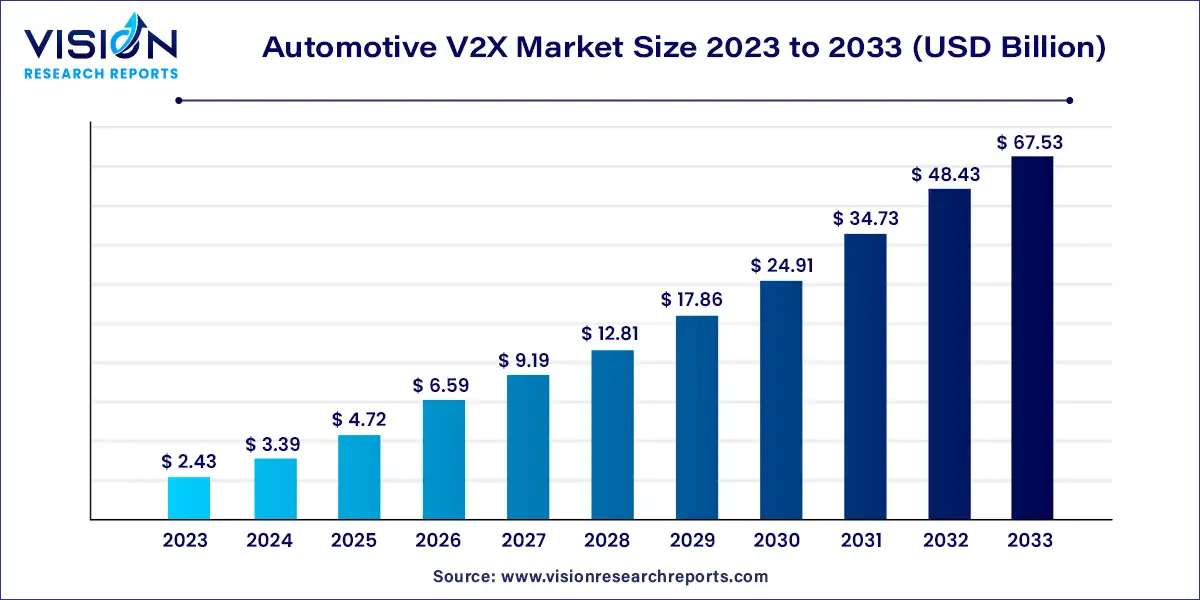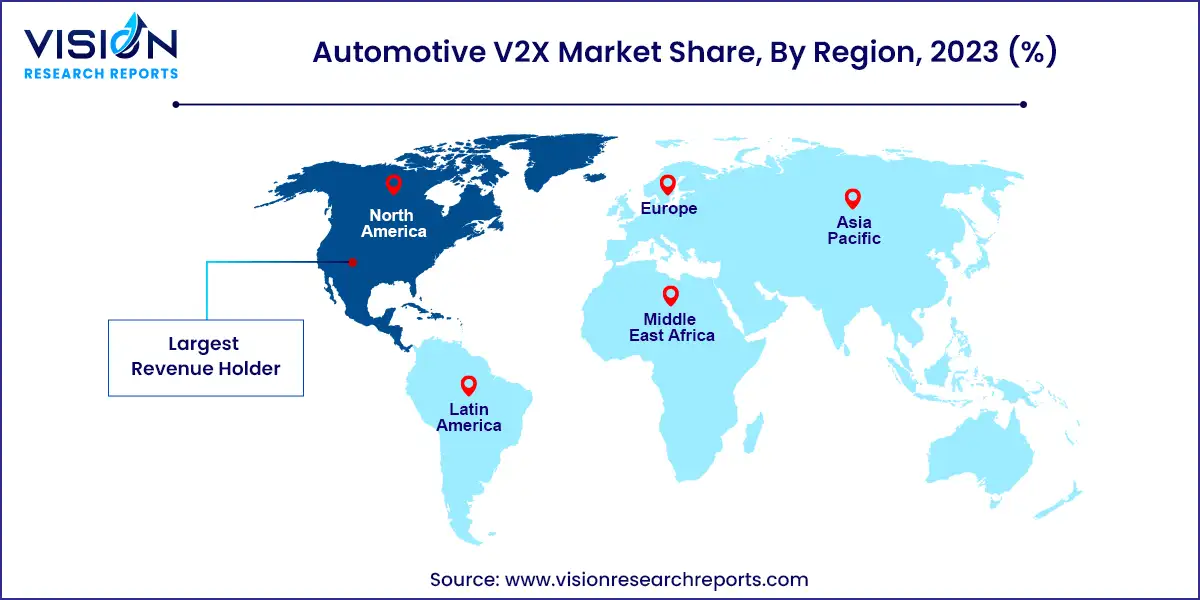The global automotive V2X market size was estimated at around USD 2.43 billion in 2023 and it is projected to hit around USD 67.53 billion by 2033, growing at a CAGR of 39.44% from 2024 to 2033. The Automotive V2X (Vehicle-to-Everything) market is evolving rapidly, driven by advancements in connectivity and the increasing need for safer, smarter transportation systems. V2X technology enables vehicles to communicate with various entities, including other vehicles (V2V), infrastructure (V2I), pedestrians (V2P), and the network (V2N).

The growth of the Automotive V2X market is significantly driven by the rapid advancement in autonomous vehicle technology necessitates sophisticated communication systems like V2X to ensure safety and operational efficiency. As vehicles become increasingly autonomous, they require real-time data exchange with other vehicles, infrastructure, and pedestrians to navigate complex environments safely. Additionally, government regulations and initiatives supporting smart transportation and connected infrastructure are accelerating V2X adoption. These policies often include incentives for integrating V2X technology into new vehicles and infrastructure projects. Technological progress, particularly in communication technologies such as 5G, is another major growth driver, enhancing the speed and reliability of V2X systems.
Vehicle-to-Vehicle (V2V) communication is expected to lead the global automotive V2X market throughout the assessment period. Increasing safety regulations are driving the adoption of various in-vehicle technologies, including Adaptive Cruise Control (ACC), driver assistance systems, lane change assistance, and blind spot detection. These advancements are significantly boosting the demand for V2V communication.
In addition, the integration of Vehicle-to-Network (V2N) and Vehicle-to-Infrastructure (V2I) technologies is set to address issues such as traffic congestion and emissions. These technologies will also enable convenient features like automated toll payments and e-parking. Consequently, the market for V2N and V2I is anticipated to grow substantially in the near future.
In terms of vehicle type, passenger cars represented approximately 76% of the market value in 2023 and are expected to maintain their dominance throughout the assessment period. The high demand for passenger cars, driven by their convenience, continues to fuel the growth of this segment.
Conversely, the commercial vehicle segment is anticipated to experience rapid growth due to the expansion of the commercial sector. According to the International Organization of Motor Vehicle Manufacturers (OICA), the sale of commercial vehicles increased by nearly 6% between 2015 and 2016. Moreover, advancements in infrastructure are likely to drive growth in the construction sector, further boosting the demand for commercial vehicles with an expected growth rate of around 30% in the coming years.
North America is projected to dominate the global automotive V2X market due to its technologically advanced landscape and large automobile market. The OICA reports that the region accounts for approximately 26% of the total global automobile population. Furthermore, issues like greenhouse gas emissions and traffic congestion in North America make the implementation of V2X systems highly beneficial. These factors are expected to significantly drive market growth in the region.

Similarly, European countries have implemented stringent emissions and safety regulations. The European Environment Agency highlights that vehicle emissions remain a major contributor to greenhouse gas emissions. In response, regulatory bodies have mandated the inclusion of safety features like blind-spot detection and adaptive cruise control, which utilize V2X communication. Additionally, the growth of battery-powered vehicles in Europe positively impacts the V2X communication market. Electric vehicles facilitate the integration of advanced technologies such as ACC and smart parking systems, further driving market expansion.
By Communication Type
By Vehicle Type
By Connectivity Type
By Region
 Cross-segment Market Size and Analysis for
Mentioned Segments
Cross-segment Market Size and Analysis for
Mentioned Segments
 Additional Company Profiles (Upto 5 With No Cost)
Additional Company Profiles (Upto 5 With No Cost)
 Additional Countries (Apart From Mentioned Countries)
Additional Countries (Apart From Mentioned Countries)
 Country/Region-specific Report
Country/Region-specific Report
 Go To Market Strategy
Go To Market Strategy
 Region Specific Market Dynamics
Region Specific Market Dynamics Region Level Market Share
Region Level Market Share Import Export Analysis
Import Export Analysis Production Analysis
Production Analysis Others
Others